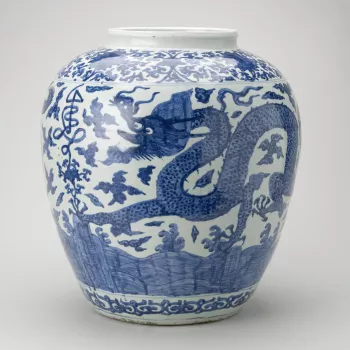Cistern with mounts cistern: mid-18th century, mounts: 1775-1800
Porcelain with deep blue glaze and gilt bronze | 80.7 x 57.0 x 57.0 cm (whole object) | RCIN 64062


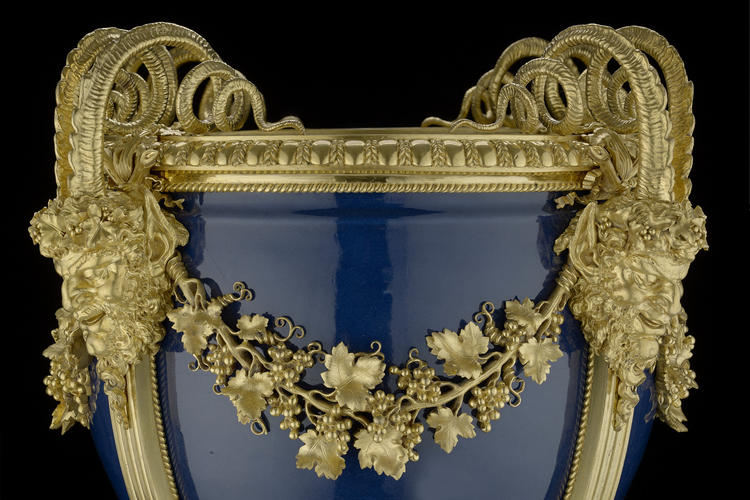
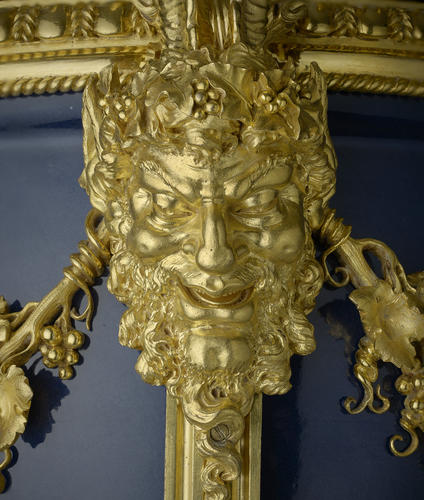
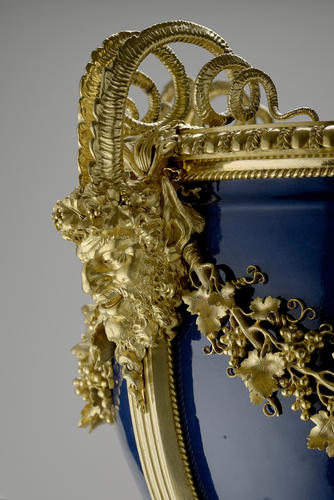
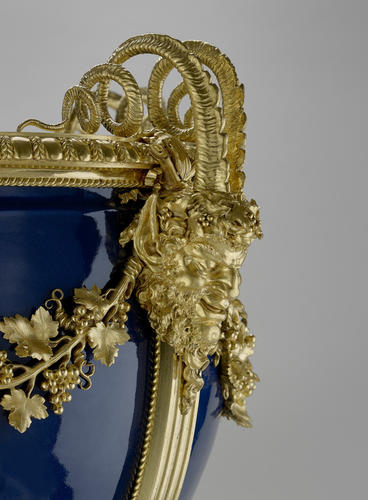
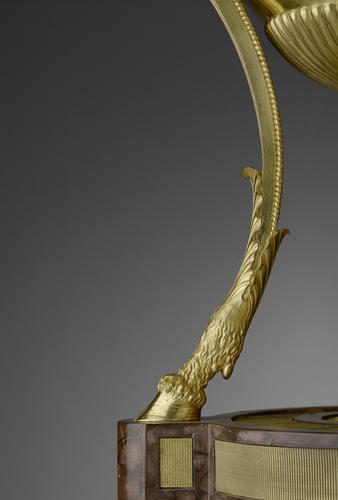


-
A Chinese porcelain cistern with French gilt-bronze mounts. A large, tub-shaped vessel, with sides curving below and rising to an indented band below the open mouth. The exterior is covered with a rich blue glaze, incidental splashes of which dot the white interior. Around the mouth rim is an egg-and-husk patterned band above a ropework lower border, below which are four satyrs' heads with horns scrolling over and onto the rim; each head sits at the top of a leg, with three flutes and a ropetwist inner moulding, and follows the contour of the sides of the vase to the base ring, then curving outwards with acanthus-stem mouldings emerging from cloven hooves. The satyr heads are linked by swags of grape vine around the sides. The base of the vase sits in a gadrooned gilt-bronze cup, with an oak-leaf and acorn border above and a berried acanthus inverted pendent finial below. The hoof feet stand on a rounded rouge griotte marble plinth, with four bow-fronted square projections at the four compass points, each supported on ball feet, set in the centre of which is an open sunflower in gilt bronze with seeded centre, its top and sides inset with ribbed sunken panels.
The purchase of this magnificent vase, one of three known examples, may be associated with a payment to the Vulliamys in March 1803: 'Delivered a Very Blue Seve [Sèvres] China Vase very richly mounted into a tripod very much ornamented with gilt ornaments executed in the best stile [sic] of Work and fixed upon a red marble plinth £200.–.–' (National Archives C104/58(I), Ledger no. 30, p. 248). The next record of this vase dates from its despatch from the Bow Room, Principal Floor (later named the Rose Satin Drawing Room), Carlton House, to the restorer Charles Brandt in October 1813, when it was described as 'A Verry Large China Vase, mounted in Or Molou with Ram Heads for Handles – the China Blue Seve' (Jutsham Dels I.136). Following the dismantling of Carlton House, it was sent to Morel & Seddon for restoration on 7 July 1828, prior to its despatch to Windsor (Jutsham Dels III.159, 219), where it was intended for Room 207, the King's Writing Room. By the time of the 1866 inventory it was in the Rubens Room (now the King's Drawing Room); in 1907 it was in the Crimson Drawing Room, by 1926 it had moved back to the Rubens Room and in recent times has been displayed in the window bay of the Crimson Drawing Room. By tradition, this vase was purchased for George IV in France by the British Ambassador (perhaps Lord Whitworth, Ambassador 1802–3; note of Interview with Queen Mary, in '1866' Windsor Castle Inventory, pp. 242–3). The mounts on the vase were attributed to Thomire on account of an incorrect identification of this vase with an entry in Jutsham Recs, described as having been supplied by Thomire and which has subsequently been identified with another vase (Jutsham Recs I.207; the Sèvres / Thomire vase is RCIN 3211. Nonetheless, the mounts are likely to be by Thomire.
An identical example was reputedly bought by Princess Rosalie Lubomirska (1768–94), at a Revolutionary sale at Versailles, for Łancut Castle, Poland, the family seat of Countess Potocka (1776–1867). There is no surviving documentary evidence for the Łancut vase's purchase at a Revolutionary sale. However, the circumstantial evidence is compelling: following the death of her husband in 1783, Princess Lubomirska spent much time in Paris, befriending Queen Marie-Antoinette, before returning to her Polish estates at Łancut. The Łancut vase is that now in the J. Paul Getty Museum, Los Angeles; it is the same size as the present vase [80.7cm high] (Watson et al. 1982).The authors Watson & Wilson 1982, also mention a further identical piece sold in Paris (Collection of Mme. Vigier, Palais Galliera, 2nd-3rd June 1970, lot 82).
Pierre-Philippe Thomire was the outstanding Parisian bronzeur and gilder of the early nineteenth century. He supplied finely chased mounts to leading Parisien ébénistes for furniture, clocks and the Sèvres porcelain factory. He was much patronised by Napoleon who made him Ciseleur de l'Empereur. His work represents some of the finest examples of Empire style. In 1804 he acquired business of the marchand-mercier, Martin-Eloi Lignereux. The company employed a large workforce in a workshop at rue Boucherat and a showroom at rue Taitbout, from where Thomire retailed a large range of decorative objects inspired by antiquity including candelabra, extravagant centrepieces, clock cases and monumental Greek and Roman style urns and vases.
Thomire collaborated with three partners, renaming the business for a time Thomire, Duterme et Cie. The business suffered as a result of France's continuing European hostilities and to avoid bankruptcy the firm was granted dispensation to trade with the Prince Regent . Soon after 1815 the partnership with Duterme was dissolved and, under the old style, Thomire et Cie thrived once more under the restored Bourbons. Thomire retired in 1823 and his two sons-in-law, Louis-Auguste-Cesar Carbonelle and André-Antoine Beauvisage, continued the business until 1852. Thomire continued to work as a sculptor and exhibited regularly at the Salon until 1834.
Text adapted from Chinese and Japanese Works of Art in the Collection of Her Majesty The Queen: Volume II.
Provenance
Purchased by George IV from Vulliamy in March 1803. Recorded as ‘A Verry Large China Vase, mounted in Or Molu with Ram Heads for Handles - the China Blue Seve from Principal Bow Room - Returned. October 1813’ (Jutsham Dels I. 136); recorded in the Principal Bow Room, Carlton House, as ‘A Very large blue Seve porcelaine Vase, mounted in or-molu, enriched with Satyr masks and feet, festoons of fruited vines, oak border and other enrichments, on circular Marble plinth, with Chased or-molu panels on the Plinth, and projecting blocks, on four ball feet 2ft 7 ½ In [80.0 cm] high (Jutsham Dels III. 219); ‘A Very large Dark blue Seve Porcelain vase mounted in Ormolu, enriched with satyr masks and feet … £250’. (Carlton House Inventory 1826, G.I, p. 143); listed in the ‘1866’ Windsor Castle Inventory, pp. 242–3, no. 347, in the Rubens Room (now known as the King’s Drawing Room) as ‘A large Oriental China Vase, mazarine blue ground …’.
Exhibited in George IV and the Arts of France, The Queen’s Gallery, London, 1966; Sèvres Porcelain from the Royal Collection, The Queen’s Gallery, London, 1978–9; Carlton House: The Past Glories of George IV’s Palace, The Queen’s Gallery, London, 1991–2. -
Creator(s)
(nationality)(metalworker)(repairer)Acquirer(s)
-
Medium and techniques
Porcelain with deep blue glaze and gilt bronze
Measurements
80.7 x 57.0 x 57.0 cm (whole object)
Category




